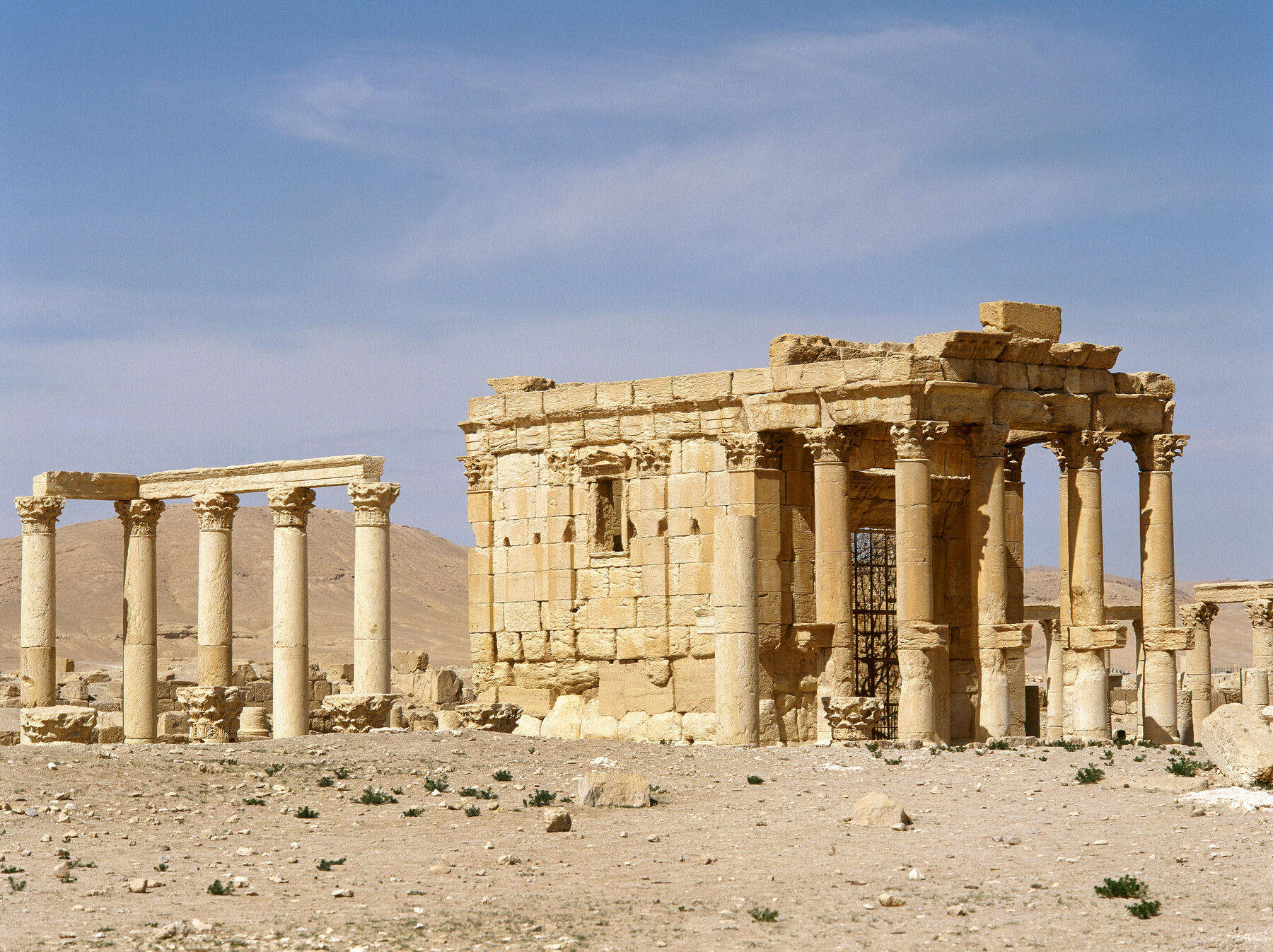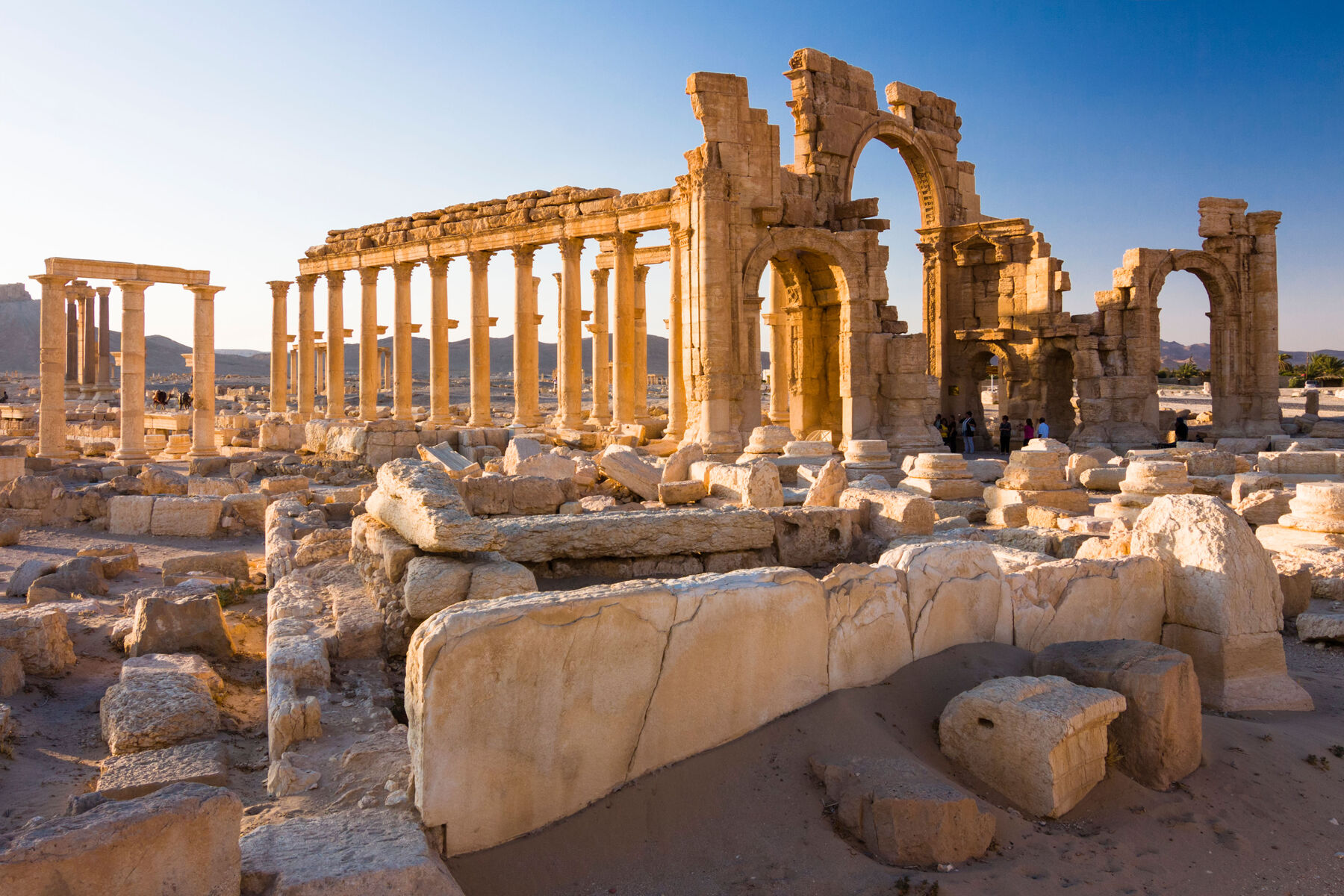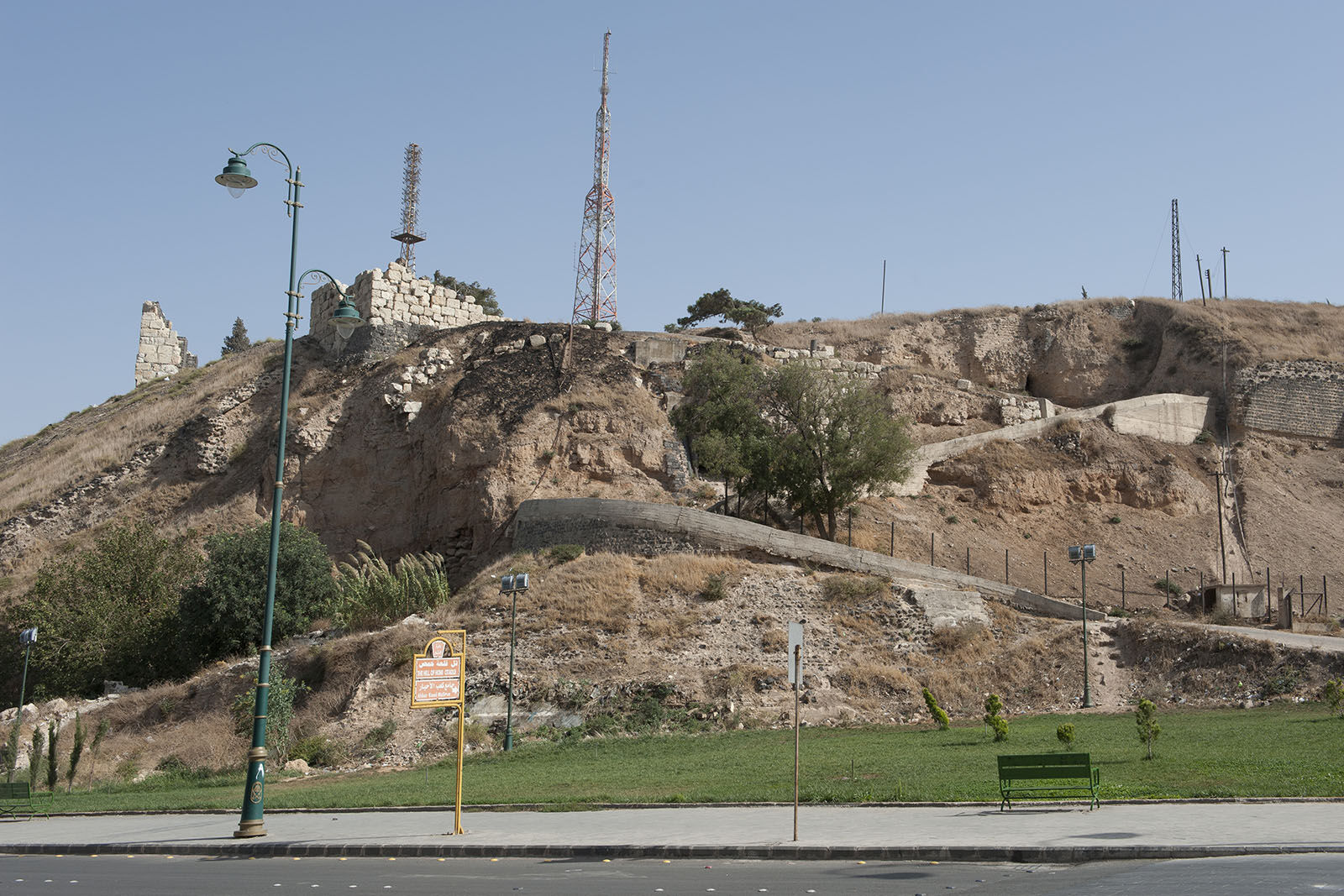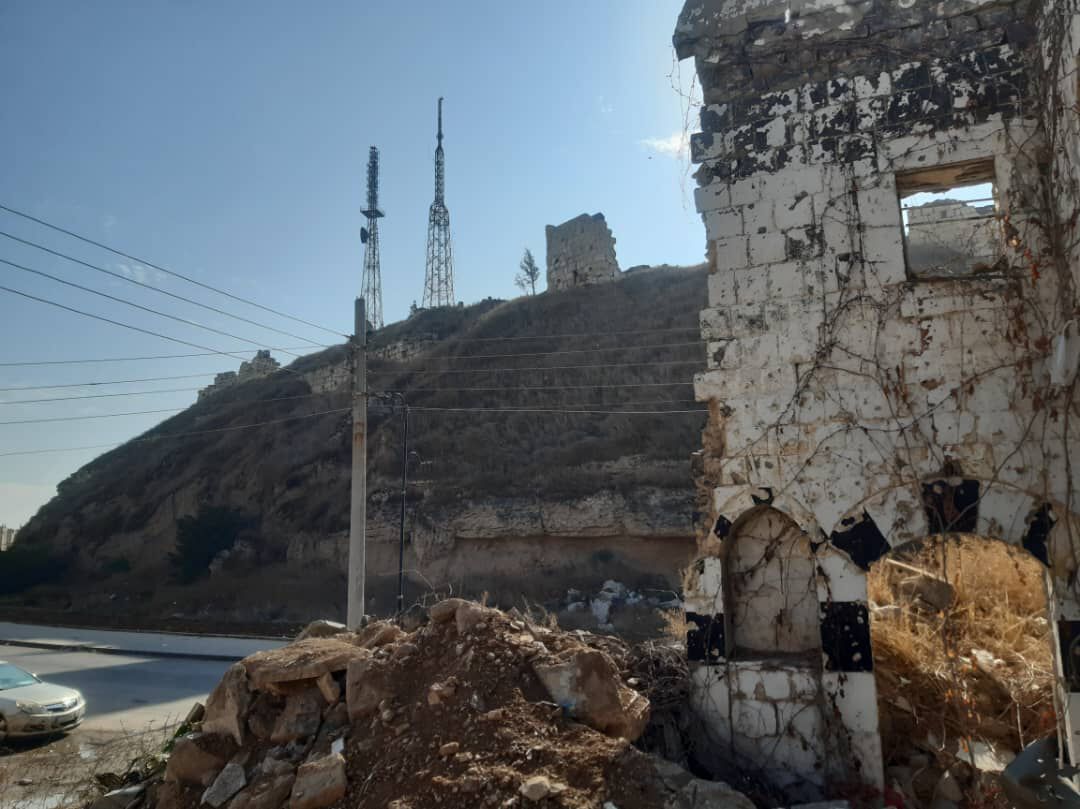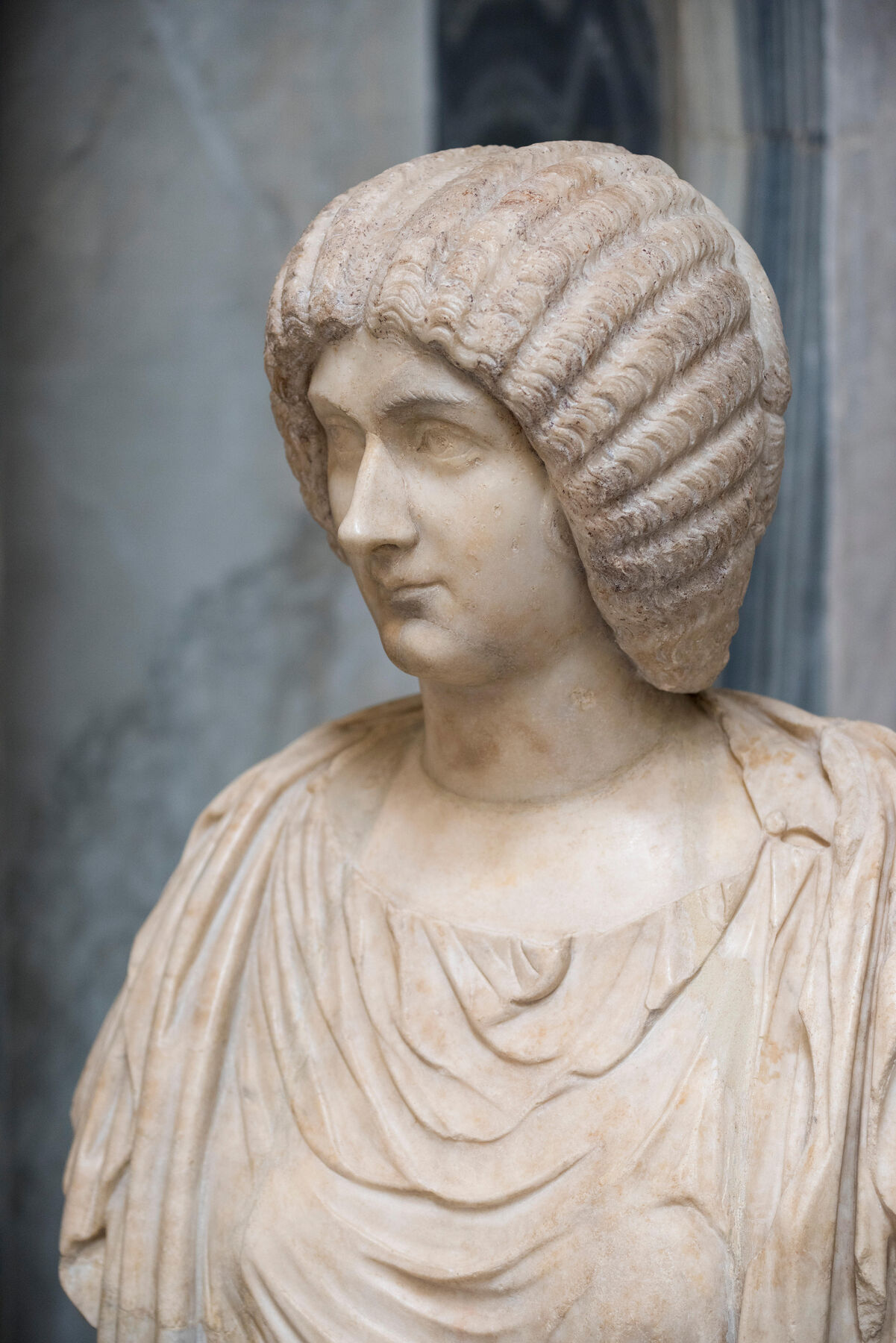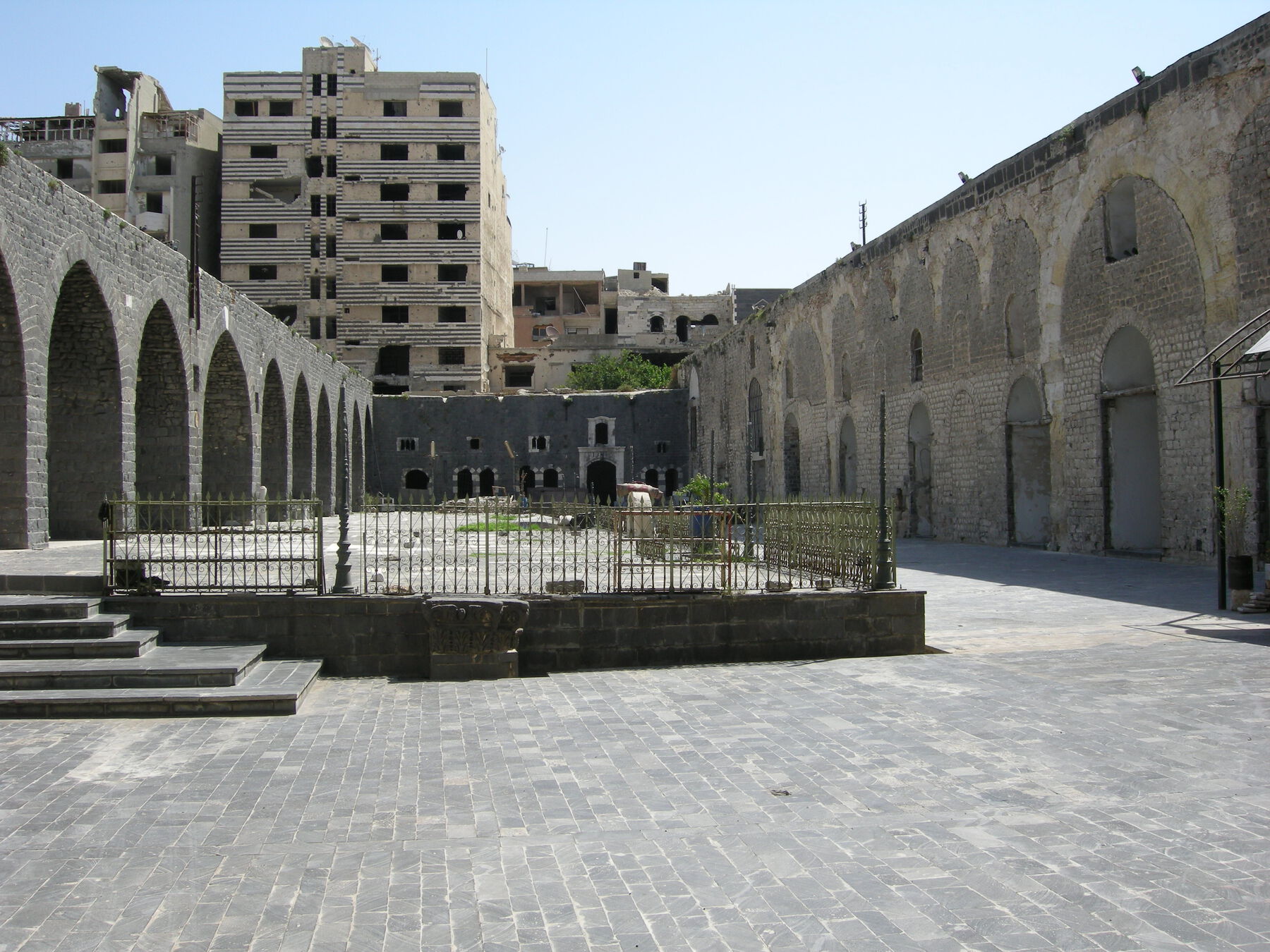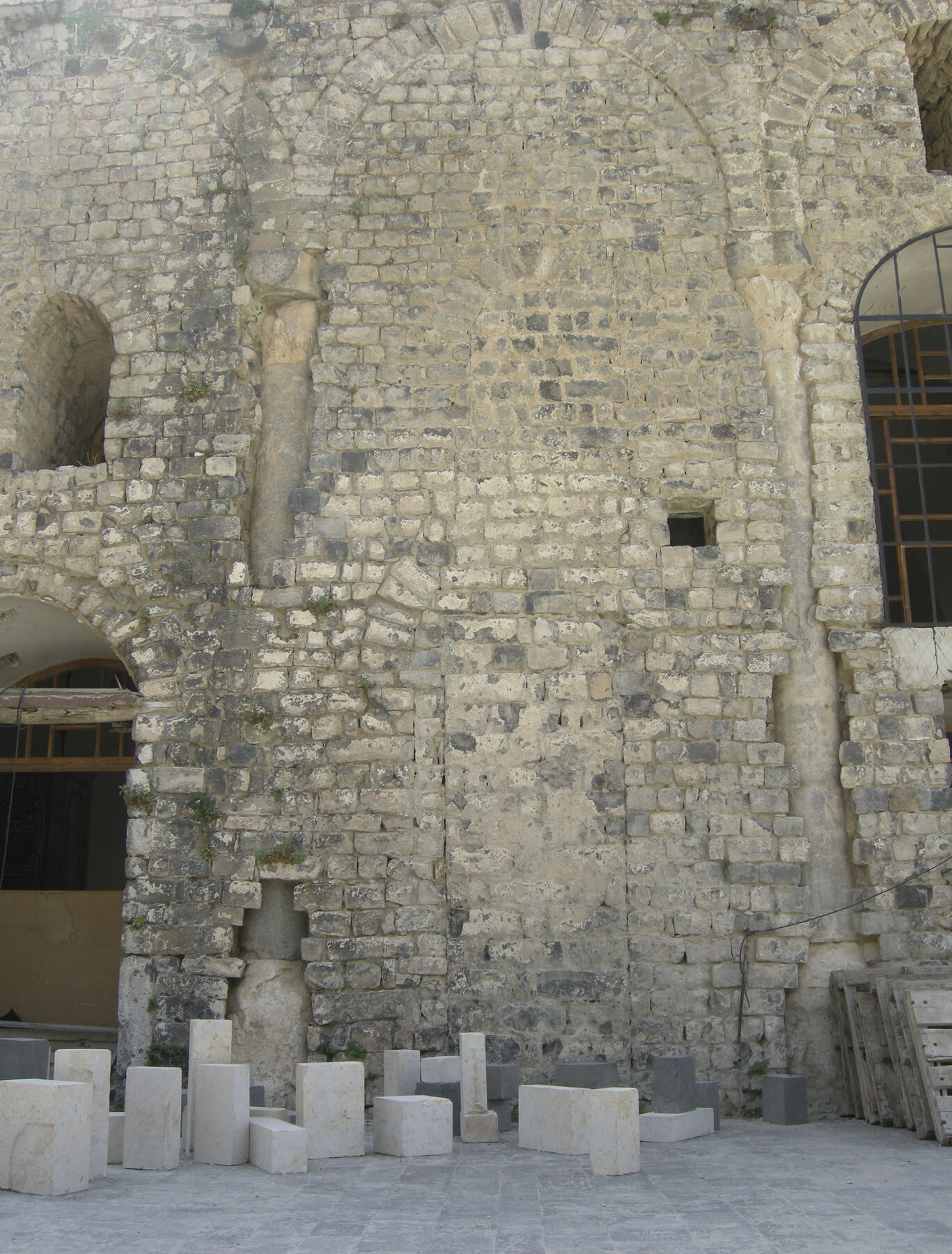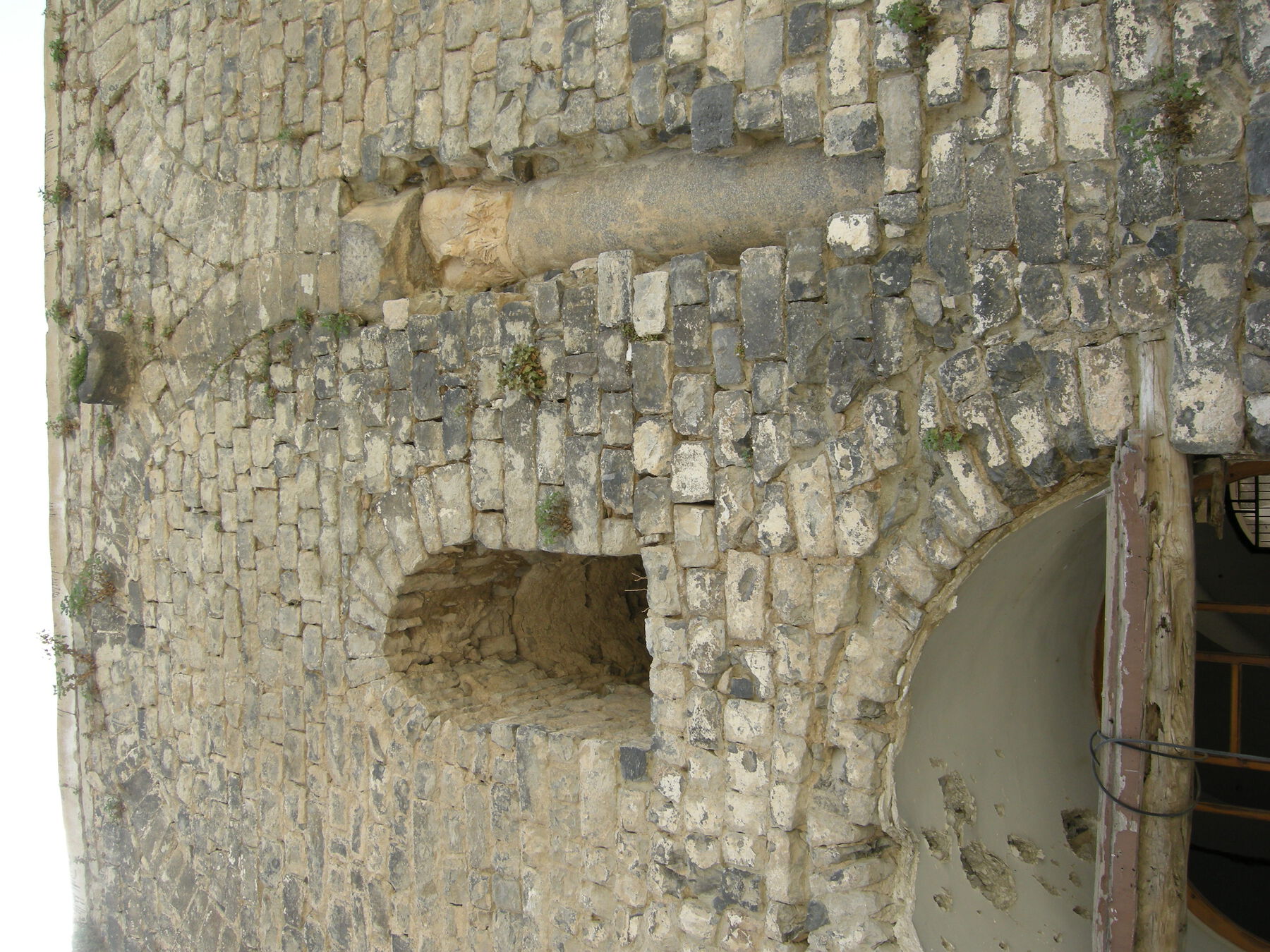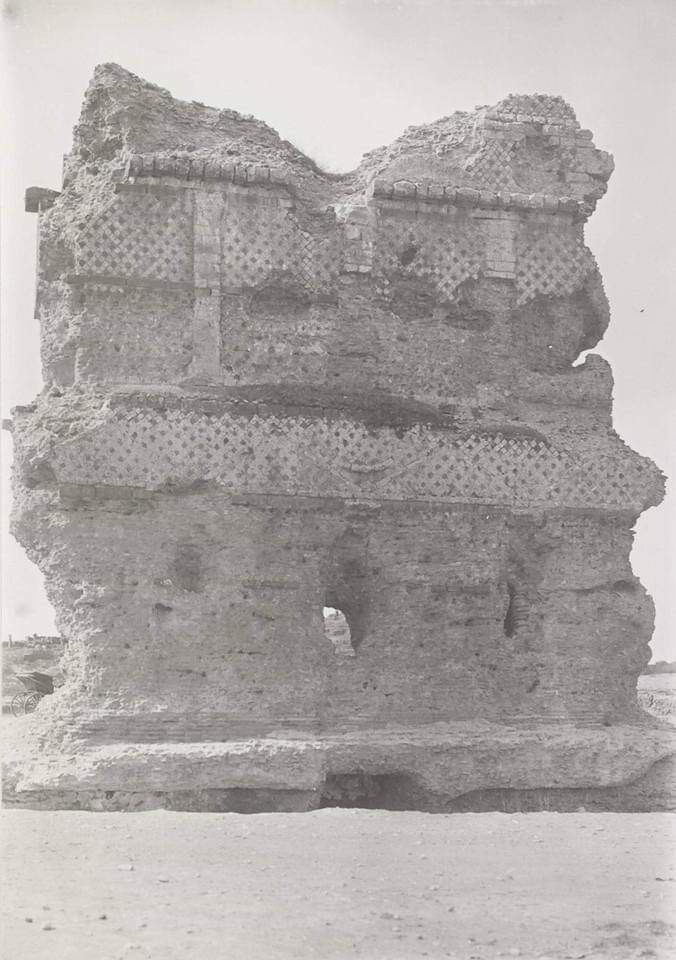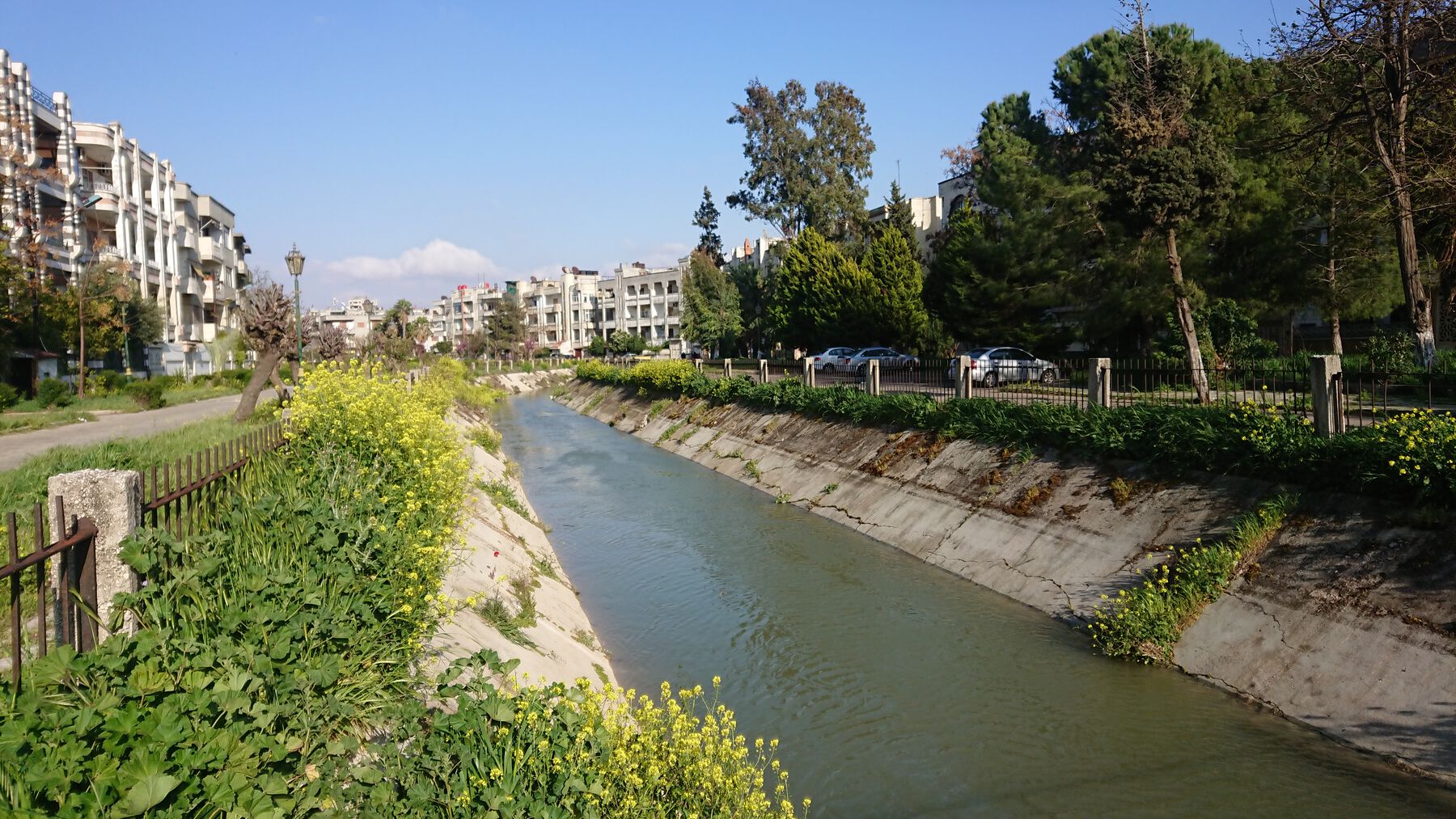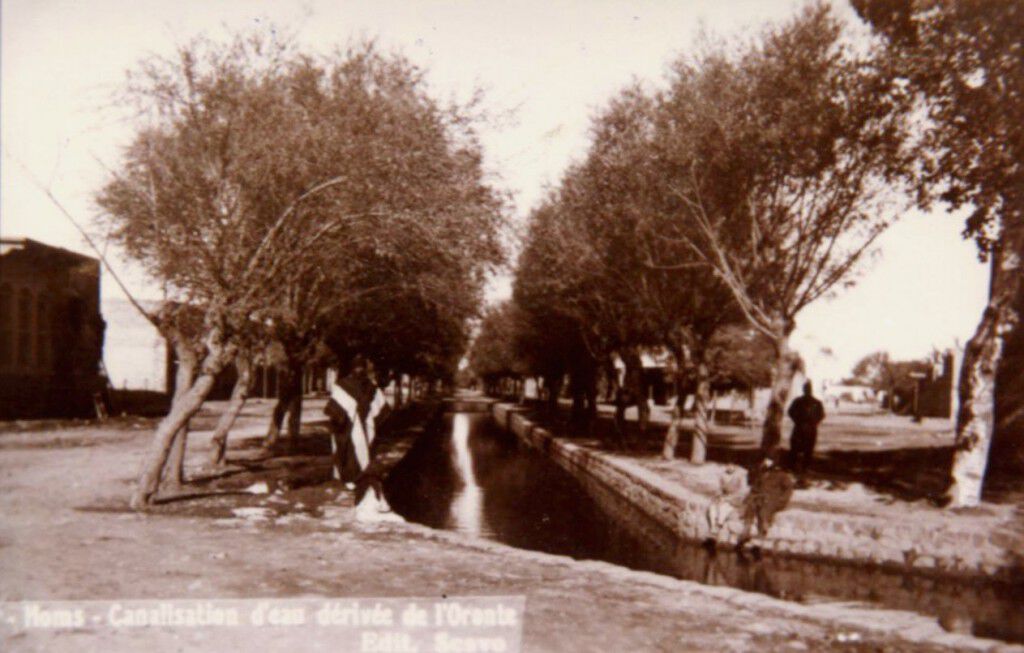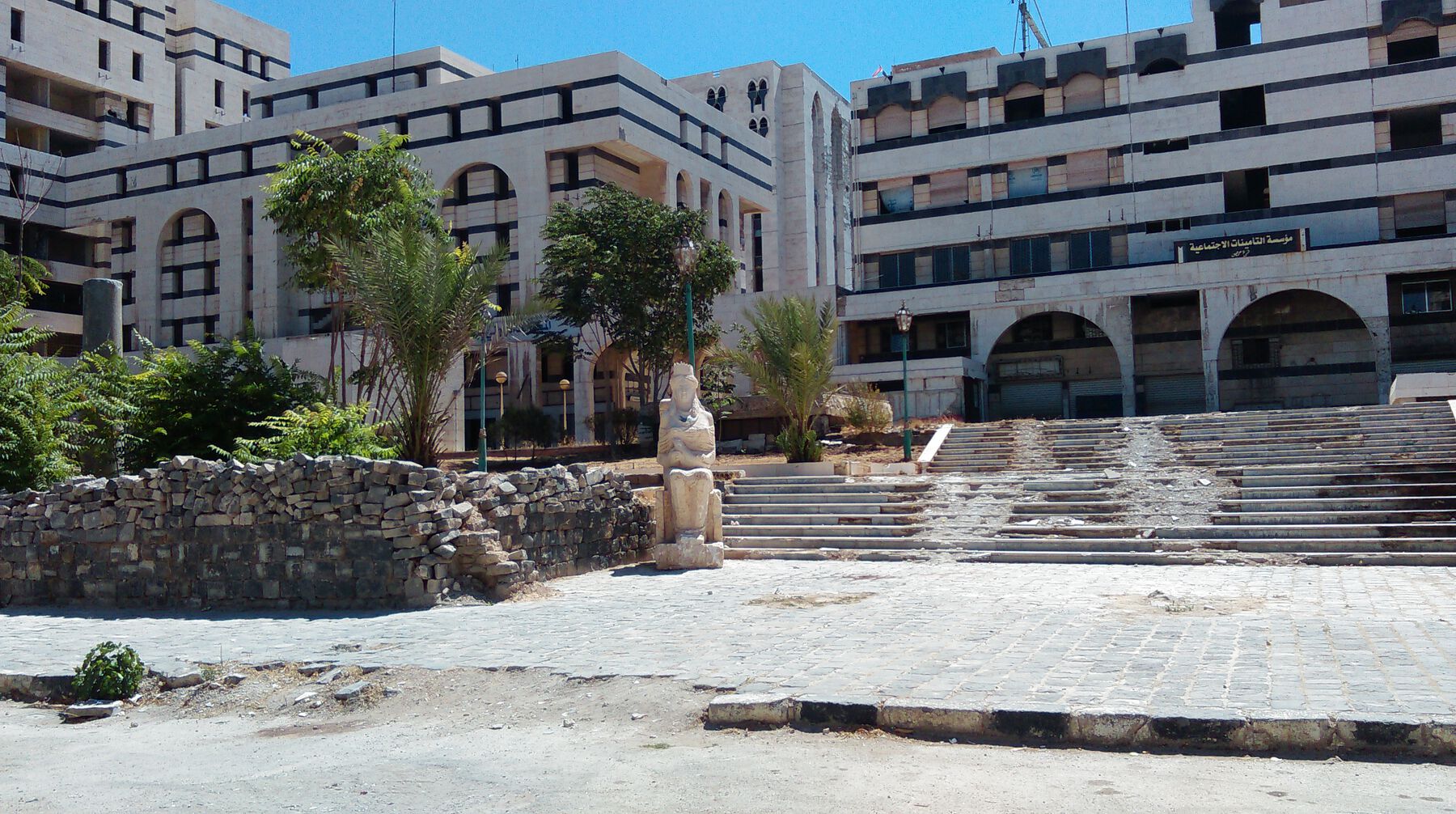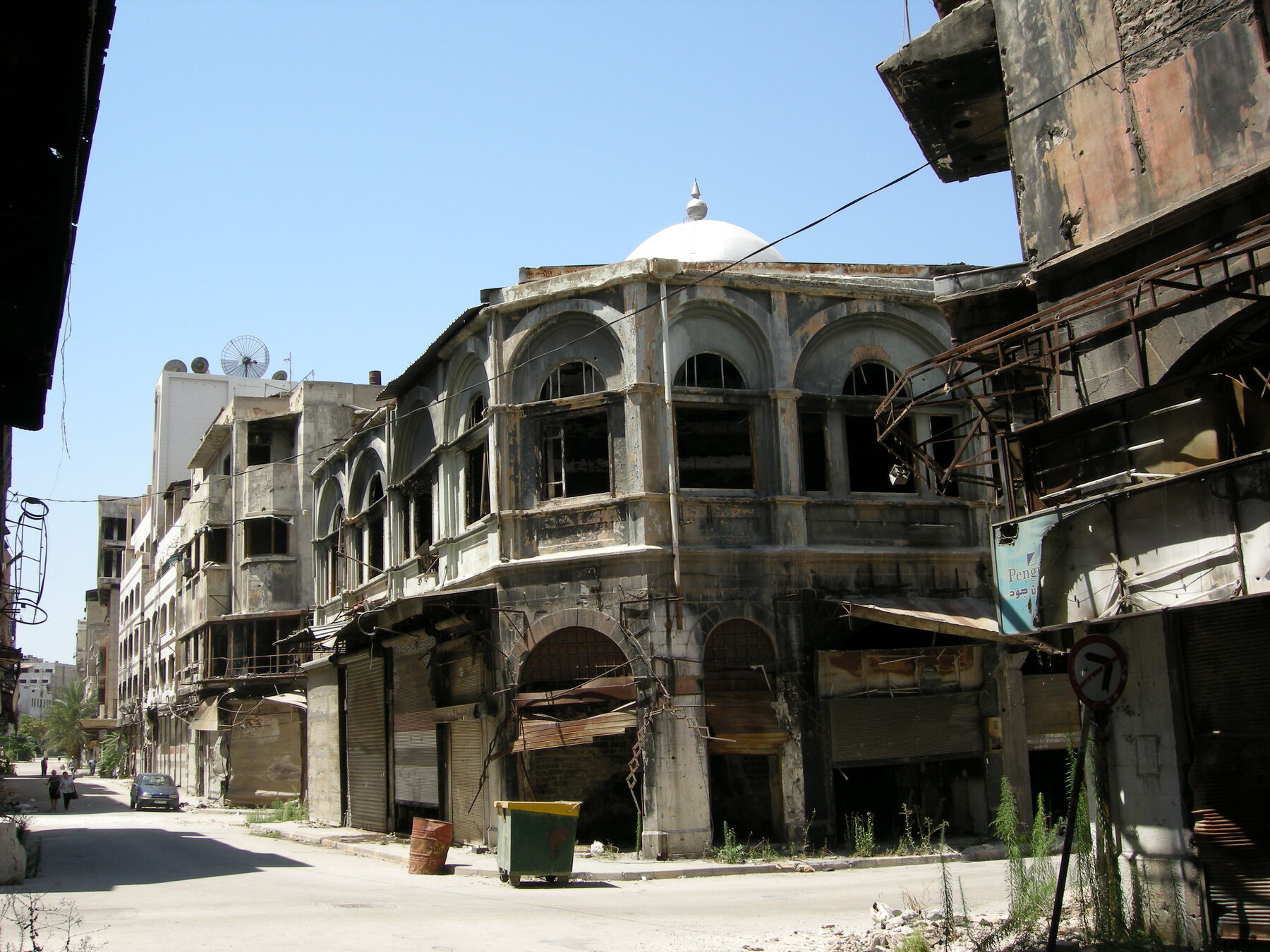11. The Lost Heritage of Homs: The Impact of the Syrian War on a World Heritage City
- Marwa al-Sabouni
تراث حمص الضائع: من تدمير المعالم إلى تدمير المعنى
مروة الصابوني
بفضل الحرب فقط، ظهرت مدينتي المغمورة في الأخبار الدولية. لكن حمص لم تكن دومًا مغطاة برماد الدمار. فقد كان لها نصيبها من المجد كمدينة قديمة أنجبت ملكة حكمت روما. يسود الغموض الظروف المحيطة باضمحلال مجدها، وهو ما يكمن بالذات في دمار مبانيها.
ملخص
خلف كل عملية خلق هناك معنى كامن أدى إلى وجود الشيء. ومن هنا، فإن الدمار المادي للمباني يشتمل كذلك على دمار غير مرئي، ألا وهو معناها. يناقش هذا الفصل تلك المعاني التي غالبًا ما يتم إغفالها في إطار عمليها الترميم والحفظ، ويُحاجج بأن السؤال عن كيفية الحفاظ على المواقع وتكوين إرثها يتعلق حُكمًا بما يتم حفظه والسبب في ذلك. وهذه مسألة تتعلق حتمًا بالقيم، ويمكن بسهولة الإفراط في تبسيطها (إلى مجرّد مسألة هوية دينية) أو الإفراط في تعقيدها (إلى نقاش متعلق بالأهمية التاريخية). يسعى هذا الفصل إلى الوصول لأرضية مشتركة في فهم قيمة التراث من خلال دراسة حالة حمص، ثالث أكبر مدينة في سوريا، ومحافظتها الوسطى التي تعرّضت لضرر هائل خلال الحرب السورية. ومن خلال العودة إلى نشأة المدينة فيما يتعلق بطبيعتها الجغرافية وتصنيفها وقيمها الثقافية والدينية، قد تكون هناك فرصة لعملية إعادة البناء وحفظ تراثها المعرَّض للخطر، وإلا سيكون مستقبلها مظلمًا.
霍姆斯遗失的遗产:从纪念碑的摧毁到意义的消失
玛尔瓦·阿萨伯尼 (Marwa Al-Sabouni)
我所在的这座鲜为人知的城市登上国际新闻头条完全是因为战争。然而,霍姆斯并非一直身处水深火热之中。在古代,它曾是一座荣耀之都,孕育了一位在罗马执政的皇后。这座城市的衰落是个谜,隐藏在惨遭摧毁的建筑之下。
摘要
任何事物都有其存在的意义。因此,建筑的损毁也意味着其存在意义的消失。本章阐述了在修复和保护过程中往往被忽视的意义,认为要回答如何保护遗址和建筑遗产这一问题,就不可避免地要考察保护的是什么以及为什么要保护它。这无疑关乎价值,而价值很容易被过度简化(变成单纯的宗教认同问题)或过度复杂化(变成围绕历史意义的争论)。本章试图通过考察在叙利亚战争中遭受大规模袭击的叙利亚第三大城市霍姆斯,力求在理解遗产价值上找到共识。作者通过重新审视这座城市的历史起源与其地理、类型、文化与宗教价值的关系,发现我们在重建与保护濒危遗产的过程中可能在其黯淡的未来中看到希望。
It was only because of war that my low-profile city made it into the international news. But Homs was not always covered in the dust of destruction. It had its share of glory as an ancient city that gave birth to a queen who ruled from Rome. There is a mystery behind its decline, which resides in the very destruction of its buildings.
Abstract
Behind every creation there is an underlying meaning that led to its existence. Hence, the physical destruction of buildings involves an invisible destruction too, that of their meaning. This chapter addresses those meanings, which tend to be overlooked in the processes of restoration and preservation, arguing that the answer to the question of how to preserve sites and built heritage inevitably relates to what is preserved and why. This is surely a question of values, a matter that could easily be oversimplified (into purely a matter of religious identity) or overcomplicated (into a debate around historical significance). This chapter seeks to find common ground in understanding the value of heritage through an examination of the case of Homs, the third major city in Syria and its central province, which sustained enormous damage during the Syrian war. By revisiting the historical genesis of this city in relation to its geography, typology, and cultural and religious values, the process of its rebuilding and the preservation of its endangered heritage may have a chance in its otherwise dim future.
Le patrimoine disparu de Homs : de la destruction des monuments à l’anéantissement de leur signification
Marwa al-Sabouni
C’est uniquement en raison de la guerre que ma modeste ville a fait la une des actualités internationales. Mais Homs n’a pas toujours été engloutie sous la poussière de la destruction. Elle a eu sa part de gloire en tant que cité antique, lieu de naissance d’une reine ayant gouverné à partir de Rome. Un mystère subsiste quant à son déclin, qui s’inscrit dans la destruction même de ses bâtiments.
Résumé
Derrière chaque création se trouve une signification sous-jacente ayant conduit à son existence. Dès lors, la destruction physique de bâtiments implique également une destruction invisible, celle de leur signification. Ce chapitre traite de ces significations, qui ont tendance à être négligés dans les processus de restauration et de préservation, en postulant que la réponse à la question portant sur la manière de préserver les sites et de construire un patrimoine est inévitablement liée à ce qui est préservé et pourquoi. Il s’agit certainement d’une question liée aux valeurs, un thème susceptible d’être aisément simplifié (en un simple sujet d’identité religieuse) ou compliqué à l’excès (en un débat sur la portée historique). Ce chapitre s’attache à trouver des points communs dans la compréhension de la valeur du patrimoine par le biais d’une étude portant sur Homs, troisième ville de Syrie et sa province centrale, lesquelles ont subi des dommages considérables durant la guerre de Syrie. Grâce à un réexamen de la genèse historique de cette ville au regard de sa géographie, de sa typologie, et de ses valeurs culturelles et religieuses, le processus de reconstruction et la préservation de son patrimoine menacé pourraient avoir une chance de succès dans un avenir qui s’annonce sombre à tous autres égards.
Потерянное наследие Хомса.От уничтожения памятников к уничтожению смысла
Марва Аль-Сабуни
Только из-за войны о моем скромном городе узнал весь мир. Но Хомс не всегда был покрыт пылью разрушения. В древности это был славный город, здесь родилась одна римская императрица. Причины его упадка неизвестны, но последствия в виде разрушения его зданий очевидны.
Краткое содержание
За каждым произведением стоит значение, которое и делает возможным его существование. Поэтому с физическим разрушением зданий разрушается и нечто незримое, то есть их значение. Глава посвящена значениям, о которых зачастую забывают при реставрации и сохранении памятников культуры. Автор показывает, что ответ на вопрос о том, как сохранить памятники и создать наследие, неразрывно связан с тем, что именно и почему мы пытаемся сохранить. Несомненно, это вопрос ценностей, которые могут быть интерпретированы упрощенно (как всего лишь религиозную идентичность) или чрезмерно сложно (как спор об их историческом значении). В главе предпринята попытка создать общую основу для понимания ценности наследия посредством исследования истории Хомса, третьего по величине города в Сирии и столицы соответствующей провинции, который претерпел масштабные разрушения во время сирийской войны. Возвращение к истории формирования города в связи с его географией, типологией, культурными и религиозными ценностями создает возможность восстановления города и сохранения пострадавшего наследия в будущем, которое без подобного осмысления весьма туманно.
El patrimonio perdido de Homs: de la destrucción de monumentos a la destrucción de significado
Marwa al-Sabouni
Fue solo por la guerra que mi discreta ciudad apareció en las noticias internacionales. Pero Homs no siempre estuvo cubierta del polvo de la destrucción. Tuvo su momento de gloria como una antigua sociedad que vio nacer a una reina que gobernó desde Roma. Cierto misterio envuelve su declive, que yace precisamente en la destrucción de sus edificios.
Resumen
Detrás de cada creación hay un significado subyacente que llevó a su existencia. Por lo tanto, la destrucción física de edificios implica también una destrucción invisible, la de su significado. Este capítulo aborda dichos significados, que tienden a pasarse por alto en los procesos de restauración y preservación, argumentando que responder a la pregunta de cómo preservar sitios y construir patrimonio se relaciona inevitablemente con qué se preserva y por qué. Sin duda, es una cuestión de valores, que podría fácilmente simplificarse demasiado (hasta convertirse en una mera cuestión de identidad religiosa) o complicarse demasiado (hasta llegar a ser un debate sobre la importancia histórica). Este capítulo busca hallar puntos en común para comprender el valor del patrimonio haciendo un análisis del caso de Homs, la tercera ciudad más grande de Siria y su provincia central, que sufrió un enorme daño durante la guerra siria. Al revisar el génesis histórico de esta ciudad en relación con su geografía, tipología y valores culturales y religiosos, el proceso de su reconstrucción y la preservación de su patrimonio amenazado podría ser esperanzador en un futuro que, de lo contrario, parece sombrío.
As an architecture student in Syria, I found it difficult to understand the different connotations of the word “heritage.” Not because I thought it was a complicated concept, but because the remnants of our ancient past stood at odds with the fleeting examples of our present. So feeble seemed the present that it could not face the past alone without calling on the future. With this apparent disconnect between the present and past, questions of identity and value seemed more pressing than ever. As “architects of the future,” as our professors encouraged us to become, we found little interest in studying the history of our city of Homs.
We were never introduced to our heritage as part of our architecture study; the future had to be designed according to the latest modernist trends taught in Western schools. Homs as a city with a history, and a heritage, was of little, if any, significance to our architectural imagination: its history, creation, and development were never discussed. Emesa, the ancient name of Homs, was shrouded in mystery, because nothing was left to tell its story. The fact that Emesa was the center of a kingdom that mediated between the Roman Empire and its eastern adversaries, was (and to a large extent still is) not relevant to the way we, as local architects, looked at our city. This was mainly because there was no trace left of those earlier cultures: not because of natural processes of erosion, but because of deliberate actions of erasure.
Homs did not make international news until it was destroyed by war; only then did its architecture make any difference. Even while at college, focusing on the paradoxes of globalization and localization, the local black basalt buildings of Homs did not seem to me or my peers to have any relevance. It was the war that later damaged those buildings that kindled in me the desire to protect them.
But the question of protection is as wide and vague as the very concept of heritage: how to protect revolves around what we protect and why. The Italian-born Brazilian architect Lina Bo Bardi, who also lived through war, had an understanding of heritage that permeated her work throughout her forty-nine-year career. She refused to look at heritage within the limited frame of Classical Italian churches and sixteenth-century Palladian architecture. Instead, industrial complexes of the 1950s and 1960s were for her structures equally deserving of protection and preservation for their “functional beauty.”
When asked, during a lecture in 1989 at the University of São Paulo, about her ideas on preservation and how she reconciled the old and the new, she answered:
This is what I was talking about when I spoke of the historical present. In architectural practice, there is no such thing as the past. Whatever still exists today, and has not died, is the historical present. What you have to save—or rather not save, but preserve—are the typical features and characteristics of a time that is part of our human heritage. … If people thought that everything old hat had to be preserved, the city would soon turn into a museum of junk. On an architectural restoration project, you have to be creative and rigorous in choosing what to preserve. The result is what we call the historical present.1
Bo Bardi seems to have rejected the word “heritage” as something only from the past, calling it instead the “historical present.” She also summarized the concept within two frameworks encapsulating the values she thought mattered most: survival through time (“what has not died”) and exhibiting features related to collective identity (“of a time that is part of our human heritage”). Perhaps examining the products of the past only through the lens of time is what creates a disconnect between what we call “heritage” and the products of our day. This conceptual divide requires creative means of reconciliation.
The disconnect becomes most evident in the aftermath of destruction and wars, because both values, survival and identity, become endangered. Under such threats the questions of what is valuable (and holds significance as such) and what is expressive (identity) come to the fore and stimulate our efforts to save and preserve remnants of the past. However, when my city was being relentlessly shelled between 2011 and 2015, I asked myself whether there is more to heritage than the threatened existential values of significance and identity. That is, whether there were other values which might call for our concern and care beyond times of crisis. These values are related to a process that precedes destruction. In realizing this, I also came to better understand the relationship between the destruction of war and the destruction of these values.
A decade after that first spark of violence, my city still stands in pretty much the same rubble it was reduced to. According to UN estimates, almost half the city’s population had been displaced by December 2013, and most had experienced multiple displacements during the course of the war. And the material structures of Homs had been reduced to a barely functioning nucleus, with 54 percent of its housing stock lost to destruction, severe losses to infrastructure, more than 60 percent of educational and health facilities no longer functioning, and the partial or complete destruction of twenty-six of its thirty-six neighborhoods. In such a context, the discussion of heritage and historical buildings may sound like a luxury, detached from reality. However, a deeper look demonstrates the opposite.
The Meaning of Heritage
Facing such enormity in human suffering and physical losses, it was strange to realize that certain structures were valued more than others. For instance, when the Roman ruins of the city of Palmyra were destroyed by the Islamic State of Iraq and Syria (ISIS, also known as ISIL or Da’esh) in 2015, including the reduction of the nearly two-thousand-year-old Temple of Baalshamin to rubble (fig. 11.1), the news went viral and the world looked on in shock and horror. Palmyra became the center of the world’s attention for months, with a 3D printed replica of Palmyra’s Arc of Triumph standing in Trafalgar Square in London, not only as a symbol of solidarity but as an example of the technological alternative on the table of restoration.
But what about the other half of Palmyra, the living half? This was a modest and modern urban settlement, adjacent to the ancient ruins, housing five hundred thousand people before the war. In the recapture of Palmyra, the town was destroyed and almost its entire population displaced. Hundreds of families dotted the road between Homs and Damascus, carrying on their backs what little remained of their lives, roaming safer parts of the country searching for shelter, scattered like the remnants of the world-mourned, historic city of Palmyra. And the world turned away from Homs.
It was no news that the living city of Palmyra was dead. What mattered was the dead Palmyra. The idea of the historical present made no sense to most people: all that mattered was the past. But this also meant that the past meant only so much to very few people: the academic elite. For the people of Palmyra, those who lived their lives marginalized next to the mysterious glory of “those rocks,” they meant much less. Why was this?
I tried to answer such questions in my book The Battle for Home by addressing the loss of belonging. Our buildings have the power to speak to us through the meanings they embody and the actions they inspire. They can represent us, by being aesthetically pleasing, functionally satisfying, but also by being related to the moral and social necessities of our lives. Our buildings have the potential to help our communities thrive and they can bring us together—but they can also cause us to drift apart. Ancient Palmyra, set as theatrical backdrop, isolated as it was next to the populated town, had a kind of centrifugal effect. At best, for most of the town’s people it was a source of financial income (fig. 11.2).
Perhaps it is easier to understand the loss of meaning in a place so detached in space and time as Palmyra than it is for places that are part of our daily lives and the actions of our people. The majority of Homs’s heritage falls into the second category. The loss of this heritage was reported during the war, but the systematic destruction and vandalism the city’s buildings endured long before the war has yet to be discussed. I tell the story in The Battle for Home, and make the case for how this process led to the current war. The process of rebuilding in the war’s aftermath may also lead to a similar path and an endless cycle of conflict. Because patterns of development focus primarily on short-term goals such as political and economic expedients, heritage, as a carrier of meaning, rarely fits into such interests unless they are used as propaganda tools benefitting those in power, as they have in the past.
Urban development, especially in the aftermath of war, rarely gains significant media coverage, placing a greater premium on quantity of coverage rather than quality. The language of numbers dominates at the cost of other values and meanings, with heritage reduced to only a number. Risks stem not only from the erasure of memory and the deepening of social wounds by the conflict, but from the architectural and urban constructs which are built in the aftermath and that fill those voids. The Battle for Home explains at length how the French urbanization of Syria transformed our cities into segregated compartments that perpetuated social divisions and led to civil conflict. Therefore, ending the cycle of destruction becomes inherently related to how we preserve meaning, and what we can do to defend and strengthen its existence in our built environment. With this is mind, an examination of the creation of the city of Homs may offer insight into how to address this pivotal issue.
The Creation of Homs and the Building of Meaning
Palmyra may be the only internationally famous part of the province of Homs. Nevertheless, Homs is Syria’s central province, stretching from the Lebanese mountain slopes in the west to the border with Iraq in the east, and contains its third largest city. Its varied landscape includes vast arable land and agricultural villages in addition to an arid region to its east (the steppe). The city of Homs, in the western center of the province (and of Syria), has experienced events throughout its history that have dictated its final location. These events include controversies that need to be addressed in order to properly understand the city’s cultural and built heritage.
The city is located two to five kilometers from the bed of the Orontes River, an unconventional location due to the nature of the terrain. Typically, cities are built on or very close to rivers, but this is not the case with Homs, which helps explain its founding and history, and consequently the story of its heritage. The current city lies atop land that used to consist of vast natural swamps, seasonally flooded by the river, making it an unsuitable location for a city. Instead, a small settlement was built on what is called “Homs hill,” a mound believed to have been created by those natural conditions, and which dates, according to archaeological research, to the mid-third-century BCE. The research findings were controversial, with some arguing that Homs hill was occupied by a small group of nomads and did not constitute an urban settlement, with the real “Homsi” metropolises scattered through different eras, as discussed below. Among these proposed alternative historical sites for the city are Qadesh, the site of the Battle of Kadesh between the Hittite and Egyptian empires in the thirteenth century BCE. Located almost twenty-four kilometers southwest of Homs, Qadash disappeared around 1178 BCE. Another development was Qattinah, a settlement fifteen kilometers south of Homs, where a Roman dam created the sixty square-kilometer artificial Lake Homs. To the north, the village of al-Mushrifah (site of the ancient kingdom of Qatanah, eighteen kilometers northeast of Homs) thrived during the third and second centuries BCE; it had been destroyed by 72 BCE. Arethusa (al-Rastan), twenty-five kilometers north of Homs, was built by the Seleucid Empire in the third century BCE. And of course, there was the Palmyra much farther away, 150 kilometers to the east. From this perspective, the current city of Homs did not acquire its importance until the Roman era (fig. 11.3).
 Figure 11.3
Figure 11.3The second perspective on the archaeological evidence argues that the hill has been a significant settlement since Hellenistic times, and that its dominance culminated during the Roman era. Yet local historians are convinced other circumstances played a more important role in the development of the hill. For instance, Mustfa al-Sufi suggests in The Establishment of a City’s History: From Emesa to Homs that the building of Qattinah’s dam during the Roman period created the right environmental conditions for the establishment of Homs, which had previously been confined to the hill. By draining the river valley of its swamps, the dam made the location habitable (figs. 11.4a, 11.4b).
The controversy surrounding the historical significance of Homs stems from data collected from aerial photography and geographical scans, along with comparisons of archaeological findings collected between 1957 and 1959. According to al-Sufi, the basis of the dispute is that despite the detection of a Hellenistic plan underlying the city, and the existence of engraved Greek writings that use the Seleucid dating system. That said, the fact that there are no remnants of monuments and buildings that can be attributed to the Seleucid era makes any historical judgment of an ancient Homs urban settlement inconclusive.
However, it is agreed that while the city’s ancient name of Emesa is pre-Roman, it continued to be used when Homs became a religious center in the first century. The solar deity Elagabalus (in Arabic al-Gabal, the Mountain) was worshipped there in a great temple of the sun; the ancient city’s coinage displayed an image of the temple with a holy basalt stone at the center. It was built by the ruling Sampsigeramids (or Emesene), an Arab family of priests who ruled after the Seleucid Empire. They made marital relationships with the Romans and ruled the city as a client kingdom.
Julia Domna, its Homsi princess and youngest daughter of the high priest of the temple, married the Libyan-born Septimius Severus, and the two ruled from Rome (fig. 11.5). Meanwhile, Homs gained prominence as a religious center with its great temple and expanded well beyond the original hill. The temple long outlived its creators by adopting new religions with new rulers over the centuries, becoming a church and later a mosque. Its remains are incorporated within the walls of the Great Mosque of al-Nuri, which was built (or rather rebuilt) by Nour al-Din al-Zenki in the Mamluk Islamic era, during which it was adjacent to the city wall at one end and the souk, or market, at the other. During the Syrian civil war, pillars believed to be remnants of the temple became exposed by arms fire (figs. 11.6a, 11.6b, 11.6c).
When I visited the mosque in the aftermath of fighting and first saw the half-exposed pillars, I was overwhelmed by the building’s sense of continuity in its development. The basalt slabs of its courtyard surface, its vaults, and its walls, were brightened by strips of white limestone around the mosque’s doors and windows. In this building, the idea of historical present was so perfectly practiced over millennia: each picking up from where the other had left, leaving no gaps in time through which meaning may slip. The word “heritage” in such places acquires another layer, belonging to no single past. It becomes an accumulation of experiences, expertise, and expressions.
But Homsis have had little chance to learn about this. “Emesa” and “Julia Domna” were no more than names of local cafés. Today, not much happens in the city. Its economic activity is slow in comparison to Damascus and Aleppo, its features are not interesting, and its history is little in evidence. Yet, none of this made sense: the city’s location is central, its weather is mild and refreshing, its fields are wide and fertile, and its crops are abundant, as is its history. So, why does the city seem to be in constant decline? The answer is multilayered, but the way in which the local government has administered the city’s heritage may provide a clue.
The mausoleum of Emesa, a monument built by the Sampsigeramids in 78–79, was formerly part of the necropolis of Tel Abu Sabun (fig. 11.7). Excavations in the tel or hill uncovered a total of twenty-two tombs, beginning in August 1936 with the discovery of the Emesa helmet, one of the most exquisite artifacts found at the site. The helmet has sustained much damage since its discovery, first during its initial looting, and later by the controversial restoration processes conducted by the French and British. The helmet, along with all other artifacts from the site, including jewelry and statues, have to this day not been returned to Syria: the only remaining aspect of the site is the built structure itself.
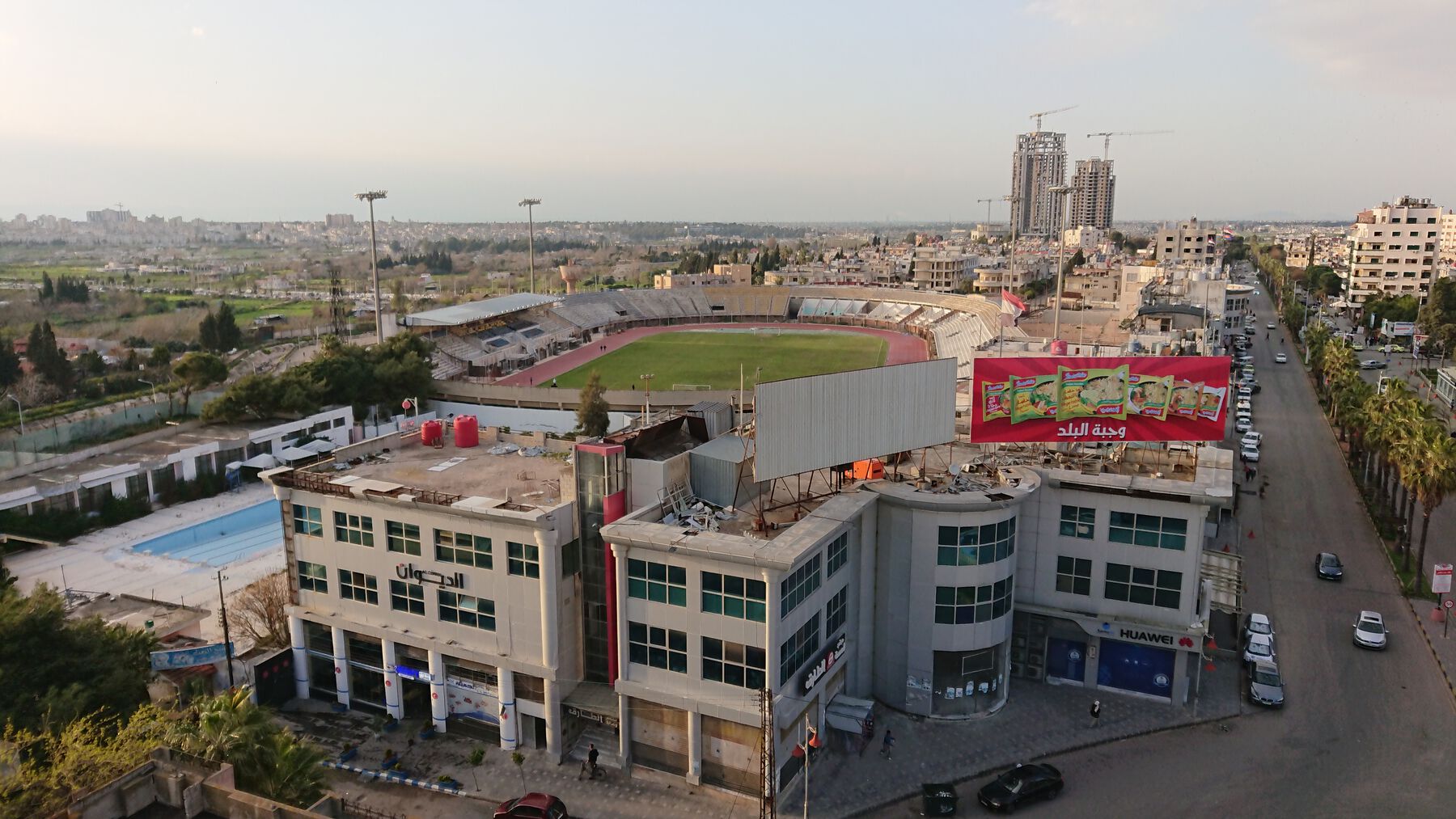 Figure 11.7
Figure 11.7The mausoleum of Emesa was part of Homs (and its necropolis) for nearly eighteen centuries, until 1911, when the city government dynamited it to make room for an oil depot. The mausoleum, as documented in the drawings and photographs of nineteenth- and twentieth-century Orientalists, was a two-story structure, the square base topped with an obelisk whose shape resembled the pyramidical tombs of Palmyra. Each façade decorated with a row of five columns at the base with another row on the second floor. The building materials, the local black basalt and white limestone mentioned earlier, are a unique feature of Homs’s architecture. The greater part of the necropolis had been excavated by 1952 and was reburied to build a municipal stadium (fig. 11.8).
One of the milestones in the making of the city was the creation of the al-Mujahediya irrigation canal by Asad al-Din Shirkuh in the twelfth century, which connected to the Qattinah dam. It irrigated the arable land between the west side of Homs and the river. But more important, it brought water right to the heart of the city for the first time, supplying mosques, hammams (public baths), mills, and all the city’s neighborhoods. The canal also protected Homs from the impact of floods that used to wreak havoc on the city (figs. 11.9a, 11.9b).
Waterwheels were built on the canal to raise the level of water where needed. A landmark waterwheel was built in 1712 near what is now considered the city center, in a neighborhood adjacent to the main souk, with numerous mosques and hammams that required water to be lifted to their level. All that remains of the great waterwheel is the name it has given to its locality: al-Naourah (after noria or waterwheel). In its place, French colonial buildings were erected, occupied by clinics and offices on the upper floors, and clothes shops at the ground level. Souk al-Naourah, as the neighborhood is called today, has no water anymore, nor a great noria (figs. 11.10a, 11.10b, 11.10c).
The Destruction of Heritage and the Undermining of Meaning
Homs has been denied many of its treasures over the centuries. The demolition of the mausoleum of Emesa was not the first. John the Baptist’s head was allegedly discovered in Homs before it was removed to the Umayyad Mosque in Damascus. The Quran of Uthman, one of the earliest copies written in the time of Uthman, the third Rashidi Khalifa and one of the Prophet’s companions, was preserved in the citadel’s mosque before being taken to Istanbul in the nineteenth century.
In Homs My Small Beloved Home, Abd al-Mueen al-Mallouhi wrote about the systematic destruction of Homs since the 1950s. Even today, after the destruction of more than 60 percent of the city, there are no signs of serious rebuilding or careful preservation. Due to the municipality’s methodical demolition of old buildings, the old quarter represents only 6.2 percent of the current city’s area, according to UN reports.
Moreover, the selective “rehabilitation” of partially destroyed monuments has exhibited flagrant examples of cultural appropriation and change of visual identity. For instance, Jami al-Arba’een (the Mosque of the Forty), is a small mosque at the northwestern corner of the ancient city wall near what is now the center of Homs. There stands the only remaining defensive tower of the wall’s structure. The cylindrical tower, built entirely of basalt, became part of the mosque by creating a connecting stair for the muezzin, who gives the call to the prayer. The mosque was built in 1568 as part of a neighborhood of the same name (the Forty), and stands adjacent to an Islamic school and orphanage built the following year, and which remained open until the 1940s. At that time the entire old neighborhood was demolished and replaced with a vast complex of public buildings. More than 80 percent of the complex stands vacant: because it was built to occupy, not to be occupied. The municipality looms over the mosque as the only remaining part of the old neighborhood. Locals recall the accident that prevented the demolition of the mosque: the bulldozers’ blades were repeatedly broken at every trial. People took that as a holy sign and demanded preservation.
The current conflict, however, did not spare the mosque from damage. Controversy was stirred when its rectangular window slabs were replaced by pointed-arch windows to resemble Iranian architecture. No protests were enough to prevent it. Even trees and water canals were not spared persistent attack: every now and then, the municipality would send teams to cut down trees that had shaded the city’s streets for decades. They had become homes for various species of bird, and a dear part of the city’s identity, in addition to their broader environmental roles. The argument for such interventions (if one is provided) is maintenance!
Why Homs has been so deliberately vandalized and denied significance over the centuries is a mystery to me. To pursue an investigation in this direction would go beyond the scope of this chapter, but one thing remains certain: the power of buildings. Valuable and meaningful buildings can at times be so powerful as to drive political forces to seek their demise for the most ridiculous reasons.
As mentioned, we may value heritage because of both significance and identity. Late nineteenth-century Western intellectuals distinguished between historical significance and cultural significance in the context of postwar historical zoning. I see the question of significance in a slightly different light. For instance, when an object or a structure survives the test of time, it gains a certain historical significance. However, what really distinguishes truly valuable objects or structures is not time alone, but their connections with the concept of “accomplishment.” What can be considered an achievement of a certain era is expressed in shapes and forms. Bo Bardi and her colleagues saw this manifest in the shape of factories in the industrial era, whereas ancient Palmyra expressed the peak of its accomplishment in transforming rocks into Corinthian crowns and majestic colonnades. Value also derives from the social status of the owners or users of objects and structures: an object used by a king is considered more valuable than one used by a commoner.
Identity, on the other hand, needs to be understood in the context of cultural significance. This can be explained through the frame of memory, visual or cultural, and in accordance with moral and religious values. Take the basalt of Homs: it holds value for the local people and it has a cultural significance that makes its architecture appealing. As a product of its natural surroundings, and as a traditional building material, it has become an essential part of Homs’s collective visual memory. Moreover, its once-enjoyed religious status in ancient pagan rituals has infused it with a sense of holiness for some time. Although its original reverence disappeared with the introduction to the monotheistic religions, the use of basalt as a major building material in Homs did not fade away until modern building techniques began to dominate the cityscape.
In fact, this transition toward modernism, whether in urban planning or in architectural forms, was so severe and pervasive that I hardly noticed traditional Homsi architecture even though I had lived in the city all my life. As mentioned above, demolishing old structures and traditional buildings was (and still is) the goal of all authorities that have taken charge in Homs. This mentality has manifested itself in all Syrian cities, but seems to have had particularly free rein outside Damascus and Aleppo (the focus of Western cultural attention). It was the war that brought the fragments of lost Homsi memory to my attention as layers of cement and cinder block fell off even the more resilient basalt walls. What was disguised as part of modern construction was exposed to its true “bone.” It was eye opening to see how the arrogant modern blocks pancaked next to dignified, partially-destroyed traditional buildings.
Also exposed by the hammer of war was the level of chaos following reconstruction: the remains of a half house in basalt topped with a cinder-block room, connected to a wooden structure, built over cement columns, and so on. I cannot see this in the spirit of “historical present,” rather for what it truly is—traces of lost meaning.
Beyond significance and identity, there are nuances in the way people name their cultural surroundings. These fall into three general categories: religious, natural, and folk cultural. I have noticed in most cases the name is all that is left to indicate the significance and identity of a place or structure. For example, Jourat al-Shayyah is a well-known neighborhood in Homs. Before it was totally destroyed during the war, it was where craft businesses aggregated on the ground floor of adjoining rows of buildings, with the top floors comprising a mix of residences and offices. But the name is strange, meaning “the hole of one who works with wormwood”! The high-density, low-rise, modern neighborhood was still young, existing in a natural trough outside the city wall where limestone used to be burnt by using wormwood in the business of calcination. The mosque of the Shayyah (one who works with wormwood) is another neighborhood landmark. One can see a clear connection between religion, work, and nature in the ways people used language to signify what mattered to them.
Homs used to be Syria’s center of Sufiism, indicated in the various places named after notable and famous Sufis. And nature is another key element in how people have related to the built environment, with al-Naourah and Tal Abu Sabun as examples of people’s activity around nature. Al-Mrayjah (the Small Meadow) is another example of this kind. Located near the old city wall, it is where harvested wheat used to be stored. In the spring, harvested wheat left the land covered in green grass, inviting the city’s residents for picnics and folk singing festivals. Al-Safsafah (the Willow Tree) was another location for folk singing, for those who enjoyed gathering under the big willow that stood in front of the al-Zaafranah Mosque (the Saffron Mosque).
In addition to religion and nature, the people of Homs have taken myth too seriously! Part of the reason is the nature of the people, who can be seen as sentimental and imaginative. Homs has always been a place where humor is connected to wit and imagination but also eccentric behavior. Jourat al-Arays (the Hole of Brides), before being bomb-flattened during the war, was an informal area with a strange name. Again the name is related to the topography, as yet another trough that turned into a small lake in winter, hence “hole,” but also because some locals believed that ghost brides used to live there, calling on those who passed during the night. Abu Jaras (that of the bell) is another ghost, a dog ghost this time, who was imagined to be peeking through the city wall, attaching the name of Takat Abu Jaras (the opening of that of the bell) to an area in the old city.
As amusing as they are, those folk tales give us an insight into heritage as an object of meaning, in contrast to one that becomes a mere trace of something from a forgotten past. Human activity lies at the center of this understanding, around which meaning can be woven. The difference between a museum-quality object and heritage is the soul that only human activity can breathe into it. Nature and religion form both the matter and spirit by which this activity can thrive.
Conclusion: From Meaningful Heritage to an Unmeaningful Trace
In this light, the destruction of nature, religion, and social fabric proves to be the real reason for the physical destruction of heritage buildings, and more importantly it can become a source of their revival. This understanding makes the mysterious disconnect between the past and present less opaque.
“Heritage” translates as erth in Arabic, whereas “trace” is athar. The two words derive from the same root, but in meaning one is clear and persistent, while the other is obscure and fleeting. More interestingly, we refer to antiquities as athar, a plural word, the equivalent of “traces.” Modern times must have taught us that if people do not guard traces, if they do not live and work around traces, they will eventually lose them. If we are serious about preserving our heritage, we must leave room for its meaning to grow.
But this cannot be done while our cities are being planned only as dispensable sources for provision, instead of realizing them as the places of meaning they really are. The example of Homs should be enough to demonstrate that blind destruction—especially when done in the name of building—not only removes those visible buildings, but also wipes away the ties embedded in them, which once held people together and to their places.
Today, Homs has been transformed from a dull city to a dead city. The piecemeal efforts toward rebuilding are hindered by the same arbitrariness and ignorance that have plagued it for centuries. Voices that advocate heritage fall on the deaf ears of the public, even before they fall short of the expectations of preservation. These voices do not resonate with the current interests and they no longer speak a common language with the public. Along with buildings we have lost, we must admit that we have lost the language in which those buildings spoke to us and we spoke to each other. I do not see a hope for Homs unless we find that meaning again and build back that language.
Biography
- Marwa al-SabouniMarwa al-Sabouni is an award-winning architect, author, and well-known international public speaker. She holds a PhD in architectural design and Islamic architecture and has published two books, The Battle for Home (2016) and Building for Hope (2021). She received the Prince Claus award in 2018 and was recognized as one of the BBC 100 Women in 2019.
Suggested Readings
- Talal Akili, The Great Mosque of Damascus: From Roman Temple to Monument of Islam (Damascus: Municipal Administration Modernisation Program, 2009).
- Marwa al-Sabouni, The Battle for Home: The Vision of a Young Architect in Syria (London: Thames & Hudson, 2016).
- Marwa al-Sabouni, Building for Hope: Towards an Architecture of Belonging (London: Thames & Hudson, 2021).
- Diana Darke, Stealing from the Saracens: How Islamic Architecture Shaped Europe (London: Hurst, 2020).
- Nasser Rabbat, Mamluk History through Architecture: Monuments, Culture and Politics in Medieval Egypt and Syria (London: IB Tauris, 2010).
- Joseph Rosa, Cathrine Veikos, and Sidney Williams, Albert Frey and Lina Bo Bardi: A Search for Living Architecture (Munich: Prestel, 2017).
Notes
Sol Camacho, “Retrospective: Lina Bo Bardi,” Architectural Review, December 2019–January 2020, 30. ↩︎
| words
